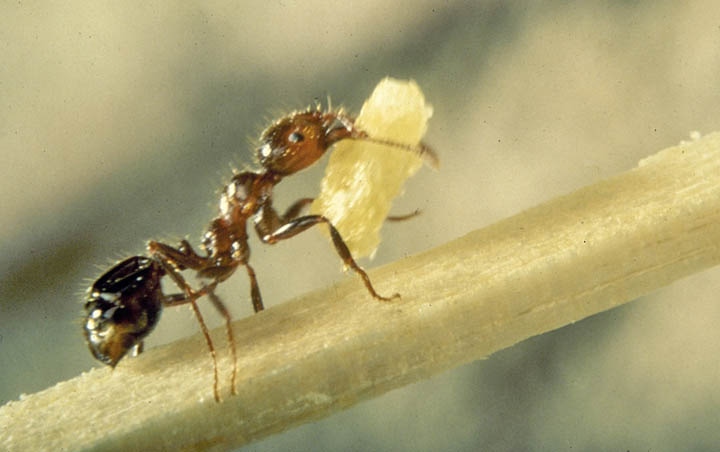January 29, 2013

I’ve been stung by fire ants more times than I can count. It’s a moment of blind panic; an initial frozen blink of time when you realize you’re being swarmed by ant devils. Panic steps aside for primal instinct and fits of bucking, jumping and flailing with movements only seen at the wildest of tent revivals.
For the uninitiated, that description may seem exaggerated, but not for those who have felt the searing burn of fire ants. It’s not the fire ant bite that hurts, but the sting. They use their jaws to clamp down and grip — and then begin stabbing with a poisoned, unbarbed stinger, injecting venom multiple times.
For a creature that’s about an eighth of an inch long, the pain it causes can be surprising — maybe startling is a better description. Enough stings at once even can bring on anaphylactic shock and cause death in some people.
Fire ants probably arrived on American shores about 80 years ago, stowaways on a ship that docked at Mobile, Ala., and quickly spread across the Southeast and then west to California. A single acre of land can house dozens of mounds and millions of ants. Invasive fire ants cost the U.S. economy over $2 billion each year — damaging farm machinery, chewing up insulation, destroying electrical systems, consuming seedling crops, killing domestic animals, and much more.
One sting: a little itching, no problem.
A few stings: Benadryl and a lot of itching; small problem.
A swarm of stings: hellfire.
Hellfire: This past fall I was taking my grade school aged kids (6 and 8) for a walk in the cotton fields around our house. Typically, we walk a few miles up and down the drainage ditches looking for snakes, frogs, fish, tadpoles or turtles — basically anything the kids can catch and bring home to show off to my wife. (Anyyyyyything will do. If it’s an off-day and they can’t find something live, they’ll proudly drag home a piece of rusty tractor metal or a chunk of driftwood.)
Off we went; all seven of us. Me, one daughter, one son, three dogs and one pistol for cottonmouths. We followed the nearest ditch for a few hundred yards until it funneled into a corrugated plastic culvert that ran under a turnrow, and finding nothing interesting, were about to cross the turnrow and keep following the ditch when all three dogs broke into a fury of rapid-fire barking aimed directly at the mouth of the culvert pipe.
Something big was moving fast inside and hitting against the pipe ribs.
I knelt down over the culvert, stuck my head in upside down and had an idiotic peek. I could see a big cottonmouth, 3 to 4 feet long, taking off for the opposite exit of the pipe. Jumping up, I ordered the kids to go to the house (They know the cottonmouth drill.) and started hollering and kicking at the dogs, trying to keep them from getting bit. In the bedlam of sending the kids home and threatening the dogs, I lost track of where the snake had gone and wasn’t sure if it had exited the pipe.
I walked across the turnrow, knelt down above the pipe’s mouth and started looking for the cottonmouth. Within five seconds, my left knee felt like it had caught on fire; like something was burrowing into the bone.
At first, I actually thought the cottonmouth had just bit me on the knee, but looking down, my knee and upper shin were covered in a carpet of fire ants. I had knelt down directly on top of a nest. There was a dark, moving flow that went from the fire ant nest directly to my knee.
Slapping, shaking and kicking had no effect. I had to run my hands down my leg in a peeling motion and that finally cleared them off.
I left my three dogs to their fate, still barking mindlessly into the culvert, and headed for the house and Benadryl salvation like Peary to the Pole. After limping home, I jerked back the medicine cabinet door and started flinging aside bottles of aspirin and Rolaids in a desperate search for Benadryl. I finally found it behind a box of G.I. Joe Band-Aids and took giant, hopeful swigs. If I was going to die, I wanted it to be from an overdose of Benadryl and not fire ant venom. I literally couldn’t count the stings. Dunno. Too many. Well over 50 pustules formed over the next few days, but there were stings on top of stings and I’ve no idea how to count those.
With 80 years of testimony, fire ants are here to stay. There will be no magic bullet to stop their march. I’m not giving an inch of ground to the invasive beasts — just moving the Benadryl bottle a bit closer.
About the Author(s)
You May Also Like






